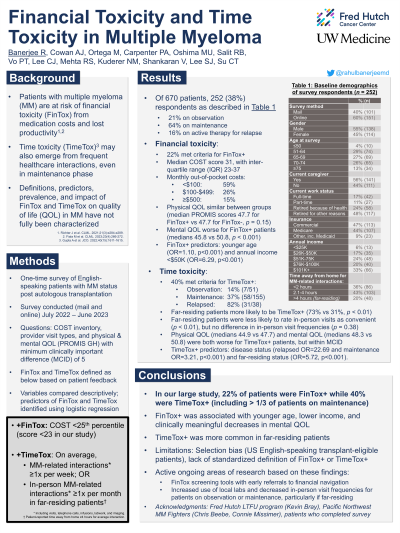QoL and Patient-Reported Outcome and Supportive Care
Poster Session 3
P-452: Financial Toxicity and Time Toxicity among Patients with Multiple Myeloma
Friday, September 29, 2023
1:15 PM - 2:15 PM EEST


Rahul Banerjee, MD
Assistant Professor, Clinical Research Division
Fred Hutchinson Cancer Center
Seattle, Washington, United States
Introduction: Multiple myeloma (MM) patients (pts) may be at ongoing risk of financial toxicity (FinTox) from medication costs and lost productivity. Similarly, “time toxicity” (TimeTox) from frequent healthcare interactions may persist into the maintenance phase of therapy. We aimed to characterize FinTox and TimeTox among patients with MM.
Methods: We conducted a cross-sectional survey (mail and online) of MM pts who had undergone autologous stem cell transplantation (ASCT) at one American institution. Questions included the validated COST FinTox inventory, questions about financial fragility (e.g., difficulty with unexpected medical expenses), frequency/nature of healthcare interactions, and symptoms (PROMIS-29). FinTox was defined as COST score in the lowest quartile (≤25 in our cohort). After discussions with content experts and local pts with MM, we defined TimeTox as (a) MM-related healthcare interactions (including telehealth & phone calls) averaging ≥1x per week and/or (b) in-person MM-related interactions averaging ≥1x per month with each interaction requiring 4+ hours away from home including transit. For FinTox and TimeTox, multivariate logistic regression were performed using age, post-transplant years, caregiver status, insurance, income, and MM status (observation vs maintenance vs relapsed) as covariates.
Results: Of 576 eligible pts, 205 (36%) completed the survey. Most (62%) were on maintenance, 22% on observation, and 16% on treatment for relapsed MM. Median age was 68 years (IQR 63-72), median time since ASCT 3 years (IQR 1-5), and median COST score 31 (IQR 25-37). 24% (n=50) were FinTox+, 39% (n=79) TimeTox+, and 12% (n=24) both. FinTox+ was reported by 26% of pts on observation, 32% of pts on maintenance, and 23% of relapsed pts. Of 79 TimeTox+ pts, 58% reported any-type MM interactions ≥1x weekly, 25% reported in-person MM visits ≥1x monthly with long transit times, and 16% both. TimeTox+ was reported by 11% of pts on observation, 35% of pts on maintenance, and 87% of relapsed pts. In univariate analyses, FinTox+ was associated with increased anxiety, depression, and fatigue (p < 0.01 in all cases), while TimeTox+ was associated with increased fatigue (p=0.01). FinTox+ was associated with skipping essential items/medications and financial fragility. In multivariate analyses, predictors of FinTox were younger age (OR=1.09, p=0.01) and income below $50K (OR=3.43, p< 0.01). The only predictor of TimeTox was relapsed status (OR=8.85, p< 0.01).
Conclusions: In our study of over 200 pts, 24% were FinTox+ (regardless of disease status) and 39% TimeTox+. FinTox+ was associated with increased symptom burden and financial fragility, and better support of out-of-pocket costs through post-ASCT maintenance and relapse may be helpful. TimeTox+ was reported by over a third of pts on maintenance, and de-escalation of low-yield monitoring during this phase of survivorship should be considered. To our knowledge, this is the largest study to date of FinTox and TimeTox in MM.
Methods: We conducted a cross-sectional survey (mail and online) of MM pts who had undergone autologous stem cell transplantation (ASCT) at one American institution. Questions included the validated COST FinTox inventory, questions about financial fragility (e.g., difficulty with unexpected medical expenses), frequency/nature of healthcare interactions, and symptoms (PROMIS-29). FinTox was defined as COST score in the lowest quartile (≤25 in our cohort). After discussions with content experts and local pts with MM, we defined TimeTox as (a) MM-related healthcare interactions (including telehealth & phone calls) averaging ≥1x per week and/or (b) in-person MM-related interactions averaging ≥1x per month with each interaction requiring 4+ hours away from home including transit. For FinTox and TimeTox, multivariate logistic regression were performed using age, post-transplant years, caregiver status, insurance, income, and MM status (observation vs maintenance vs relapsed) as covariates.
Results: Of 576 eligible pts, 205 (36%) completed the survey. Most (62%) were on maintenance, 22% on observation, and 16% on treatment for relapsed MM. Median age was 68 years (IQR 63-72), median time since ASCT 3 years (IQR 1-5), and median COST score 31 (IQR 25-37). 24% (n=50) were FinTox+, 39% (n=79) TimeTox+, and 12% (n=24) both. FinTox+ was reported by 26% of pts on observation, 32% of pts on maintenance, and 23% of relapsed pts. Of 79 TimeTox+ pts, 58% reported any-type MM interactions ≥1x weekly, 25% reported in-person MM visits ≥1x monthly with long transit times, and 16% both. TimeTox+ was reported by 11% of pts on observation, 35% of pts on maintenance, and 87% of relapsed pts. In univariate analyses, FinTox+ was associated with increased anxiety, depression, and fatigue (p < 0.01 in all cases), while TimeTox+ was associated with increased fatigue (p=0.01). FinTox+ was associated with skipping essential items/medications and financial fragility. In multivariate analyses, predictors of FinTox were younger age (OR=1.09, p=0.01) and income below $50K (OR=3.43, p< 0.01). The only predictor of TimeTox was relapsed status (OR=8.85, p< 0.01).
Conclusions: In our study of over 200 pts, 24% were FinTox+ (regardless of disease status) and 39% TimeTox+. FinTox+ was associated with increased symptom burden and financial fragility, and better support of out-of-pocket costs through post-ASCT maintenance and relapse may be helpful. TimeTox+ was reported by over a third of pts on maintenance, and de-escalation of low-yield monitoring during this phase of survivorship should be considered. To our knowledge, this is the largest study to date of FinTox and TimeTox in MM.
